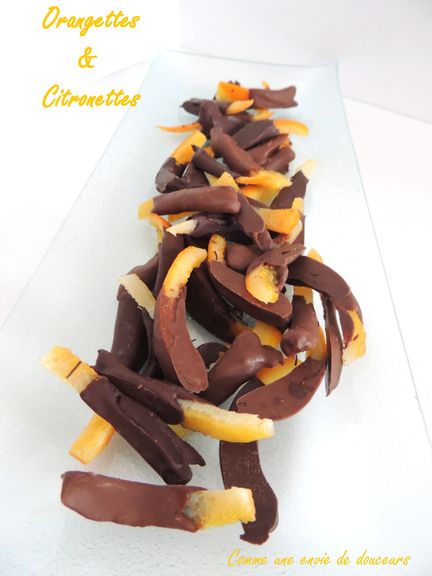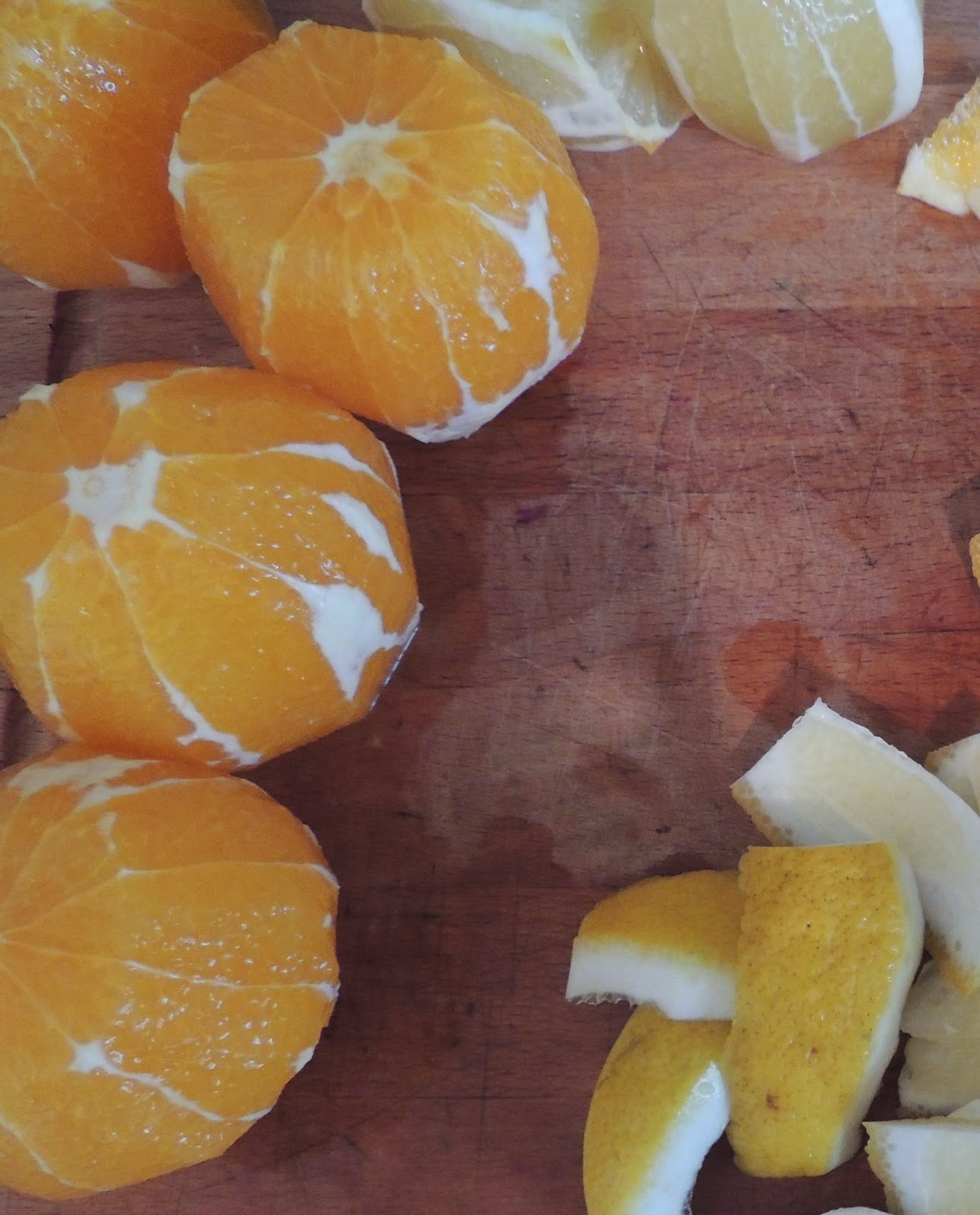Écorces d’oranges et de citrons confits
4 oranges (fruits bios si possible)
Sucre (450g pour moi, même poids en écorces qu’en sucre)
Eau
4 oranges (organic if possible)
2 lemons
Sugar (for me 450g, same weight in sugar than fruits peels)
Eau
°A réaliser la veille. Vous pouvez diminuer ou augmenter le nombre de fruit, vous ajusterez le dosage de sucre, pour répondre à vos besoins.
°Make it the day before. You can reduce or increase the number on fruits depending on your needs. Just adjust the weigh in sugar.
°Rub your fruits with water to wash it and dry it.
°Start by “raw peel” the fruits:
-With a long sharpen knife, cut the two bases of your orange or lemon in order to make your fruit standing by itself.
-Découpez l’écorce en faisant glisser la lame du couteau (pas de mouvent de scie) sous l’écorce et en suivant la courbe naturelle du fruit, sans trop en entamer la chair. Pour ceux qui connaissent: comme pour faire des suprêmes.
-Peel the fruit in following the fruit’s shape and curve and without cutting to much “flesh”. Glide the knife blade under the peel (no sawing motion). As you do to make segments (if you now it).
– Continuez ainsi, lamelle par lamelle jusqu’à avoir pelé tout le fruit.
-Continue like that, slice by slice until totally peeled.
-Il ne reste plus que des petits morceaux de peau blanche sur l’orange.
-There’s only some patches of white skin left on the fruit.
-Si vous le souhaitez vous pouvez découper des rondelles de cette orange (ou citron), pour chemiser un moule ou autre, ou encore faire des suprêmes d’oranges (segments d’oranges délestés de leur peau et pépins), pour décorer des desserts, ou pour faire des salades de fruits ou autres…
– If you want it you can cut slices of that fruit to coat a mold or other things, or you can cut segments, supremes of oranges (segments without skin and seeds), to decorate desserts, plates, or meals, making fruits salads…
°Pour faire des suprêmes, après avoir pelé à vif votre orange, tenez la dans le creux de votre main; vous voyez bien les membranes qui séparent les différents segments d’orange; glissez la lame du couteau juste à côté d’une membrane et ce jusqu’à atteindre le milieu du fruit.
°To make supremes, after peeled your oranges and lemons, take it in the middle of your palm; you can see the walls that separate each segments of the orange; glide your knife bladejust next a wall until you reach the middle of the fruit.
-Faites la même chose de l’autre côté du quartier et voila votre segment d’orange se détache, dépourvu de sa peau, s’il il y a des pépins enlevez les.
-Do the same for the other side of the segment, your segment get loose from the orange, without skin left on it, take off seeds if there are.
-Do the same for the other segments.
-A la fin il ne vous reste plus que la membrane des quartiers. Pressez la pour récupérer le jus.
– At the end there’s only left the walls. Squeeze it to extract the juice.
°Once your fruits peeled, cut your peels in about 5mm stripes.
°Dans une casserole mettre les lanières d’écorces, remplir d’eau froide à hauteur et portez à ébullition. Dès ébullition stoppez la cuisson 1 minutes puis reportez à ébullition, faire ceci 3 fois.
°In a saucepan put the fruits, pour cold water to cover it and bring to boil. When boiling stop heating for 1 minute and bring to boil again. Do it 3 times.
°Drain, cool with cold water.
°Weigh the peels in the saucepan, had the same weight in sugar (for me: I had 450g peels so 450g in sugar), cover with cold water.
°Cuire 20-30 minutes à feu moyen, goûter pour être sûr(e), si les écorces sont encore dures à croquer alors ce n’est pas cuit.
°Cook for 20-30 minutes until it’s cooked, not to hard to bite.
°Laissez refroidir dans leur sirop, égouttez (gardez le sirop, pour faire un caramel à l’orange, ou des bonbons de caramel ou pour l’utiliser si vous faites des cannolis), passez sur du papier absorbant et laissez sécher 24h sur une grille à l’air libre.
°Let it cool in this sirup, drain (keep the sirup to make caramel sauce or candies, or to make cannolis), put on an absorbing paper and then spread on wire rack, let dry for 24 hours.
°Melt some chocolate (quantity depending on how many oranges you started with), dark or milk as you like. Melt it at warm temperature or temper it (not translate in english yet but the purpose of tempering chocolate is to pre-crystallise the cocoa butter in the chocolate, which is related to the working temperature of the chocolate. That allows the chocolate to be shiny after cool and to prevent it from melting to fast, so you can keep your orangettes outside the fridge.
This process is to follow the higher melting temperature: dark chocolate 45/50°C, milk chocolate 40/45°C, white and colored chocolates 36/38°C.
Then after melting chocolate, lower the temperature to make the chocolate crystallise eventually bring it up to obtain the working
temperature.
For dark chocolatelower the temperature at 26/27°C with a cold water bath, then bring it up at 31/32°C. For milk chocolate follow the same process
with 24/25°C then 29/30°C, and white chocolate with 23/25°C then 27/28°C.)
°Trempez votre écorces confites dans le chocolat, secouez pour enlever le surplus et laissez sécher sur une feuille silicone ou papier cuisson. Au frais pour allez plus vite et se jeter dessus plus vite!
°Soak your candied peels in the melted chocolate, shake to take off the extra chocolate, let dry on a silicone or baking sheet. Put in the fridge to dry faster and devour it faster!















Alors ça, ça se mange tout seul !